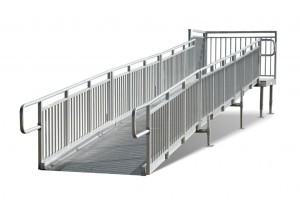Federal Law requires all commercial, industrial, and public buildings to have ADA compliant wheelchair ramps. This law was designed to foster inclusivity by enabling those with mobility problems to access buildings more conveniently. At REDD Team, we design and manufacture aluminum access products, including ramps and steps. We understand that quality standards offer construction guides and ensure maximum usability and safety.
Guidelines
 The ADA bill was signed into law in 1990 by President George H.W Bush. The law prescribed the civil rights protecting those with disability and outlined the standards for access to all public spaces and buildings to prohibit discrimination against the disabled. The guidelines set by the ADA define the requirements for ramps. These include:
The ADA bill was signed into law in 1990 by President George H.W Bush. The law prescribed the civil rights protecting those with disability and outlined the standards for access to all public spaces and buildings to prohibit discrimination against the disabled. The guidelines set by the ADA define the requirements for ramps. These include:
- A minimum flat surface area of 4*5 at the door when the ramp is linear or straight
- A minimum flat surface area of 5*5 at the door when the ramp curves at a gentle angle
- A width of four feet or longer
- This formula determines the steepness of the ramp slope. Have a pitch of 1:12, meaning that every inch of elevation should have a corresponding 23 inches of the ramp area. Following this guide should result in a 4:8 slope. The ramp should not be too steep to hinder access for people with mobility problems.
- Have handrails on both sides of the slope for user safety. They should be continuous and sit about 2.8 feet to 3.2 feet above the ramp floor area.
- Have a resting platform of 4*5 or 5*5 for every ramp extending past the 30 feet mark to allow the user a break when traveling up the ramp.
- A stiff, even exit platform with an area of 5*5, preferably made of concrete or landing pads. If this landing is made of gravel, it should not compromise maneuverability. However, the exit platform must not comprise grass, dirt, or muddy surfaces.
- All edges must have railings for protection, so there is zero risk of falling off at any elevation point. The surface of the ramp should have anti-skid features to allow better grip and use in wet conditions.
Why use ADA Wheelchair Ramps?
The most compelling reason is that the law dictates. Apart from regulations, there are many benefits of using wheelchair ramps.
Independence
They offer greater mobility and freedom to people living with mobility problems. The challenge of using a wheelchair is less intense with easy and fast access to industrial and commercial facilities. Buildings with wheelchair ramps installed according to ADA guidelines instill confidence in users to enter and exit conveniently, with little or no aid.
Lowers Risk
Stairs increase the chances of falls, slips, and skids for people with mobility problems. Because stairs don’t support wheelchair access, the advantages of a gently inclining ramp are clear.
Access
Stairs facilitate building access for people without mobility problems. The frail, old and sick find them physically imposing as the inclining step requires effort to climb. Installing ADA-compliant ramps in commercial and industrial facilities ensures quick and convenient access for people with mobility problems.
Doorways
Wheelchair ramps, in most cases, feed to easy-to-access doorways, which are not typically present in buildings without ramps. Ramps make it easier to cross obstacles on openings.
REDD Team manufactures durable wheelchair ramps for industrial, commercial, military, and municipal buildings. Our wheelchair ramps are durable aluminum, unaffected by the elements, including excessive sunlight and rain. In addition, we offer our products at some of the best rates on the market.
Installing an ADA-compliant wheelchair ramp in your industrial or commercial building shows that you care about equal access. Visit the REDD Team website to learn more about our products.
